Larch Bolete
A very common Suillus when around Larch trees. The Suillus grevillei var. badius is rarer, has a chestnut brown cap and is mainly found in Western Scotland.
| Mushroom Type | |
| Common Names | Larch Bolete (EN), Greville's Bolete, Boled Llarwydd (CY), Maślak Żółty (PL), Sárga Gyűrűstinóru (HU) |
| Scientific Name | Boletus / Suillus grevillei |
| Season Start | Jul |
| Season End | Nov |
| Average Mushroom height (CM) | 8-11 |
| Average Cap width (CM) | 6-9 |
Cap
6-9cm. Bright yellow, darkening to burnt orange on older specimens. Starting convex but flattening in older mushrooms. The cap is viscid and looks shiny even when the weather is dry and is covered in slime. The variant badius has a chestnut brown cap.
Pores
Sponge like, angular, bright yellow pores that darken with maturity and will bruise a rust colour.
Stem
8-11 cm long, 1.5-2 cm diameter. Yellow with brown scales underneath the veil like skirt and smooth above. Before the mushroom fully opens the pores are covered by a fine web like veil which joins the edge of the cap to the stem, when this comes away it forms the skirt.
Possible Confusion
Growing under Larches and being a Suillus, part of the Bolete family, it is difficult to mistake this mushroom for anything other than the Bovine Bolete (Suillus bovinus), pictured, but this does not have a skirt.
When young, the fine web like veil covering the pores could lead you to misidentify this mushroom with a few of the Cortinarius species.
Spore Print
Oche-sienna coloured. Subfusiform.
Taste / Smell
This mushroom holds so much water that it really needs drying to get a flavour and texture from but as it holds so much water it dries to next to nothing, otherwise it can be added to soups and stews to bulk them out. Should be cooked before consumption.
Frequency
Common.
Other Facts
It is best to remove the skin of the cap, because of the slime, and the pores as it is these that can produce gastric upsets in some people. Must be cooked before consumption.
Suillus are not the best mushrooms when used fresh but are improved by slicing, drying and then re-hydrating.



 (44 votes, average: 3.27 out of 5)
(44 votes, average: 3.27 out of 5)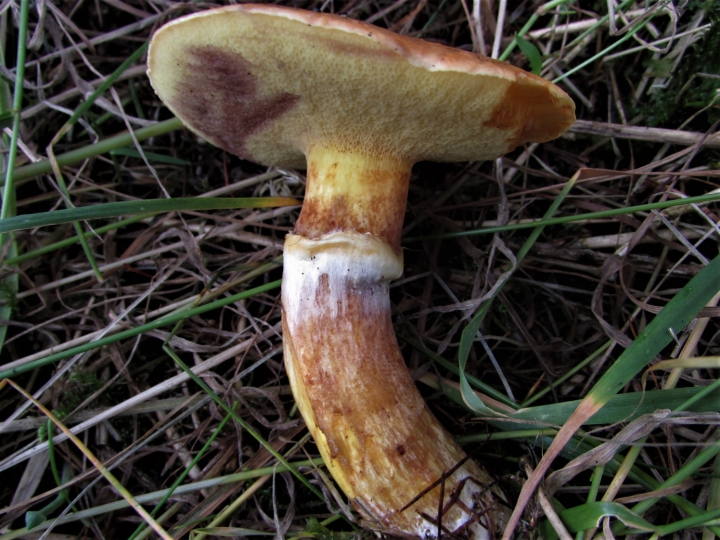















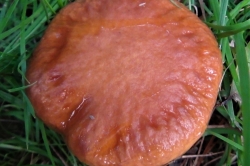
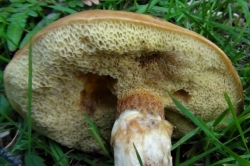
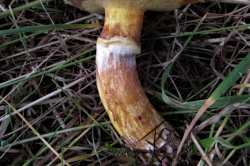
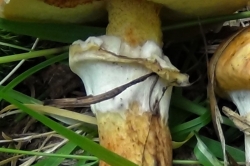
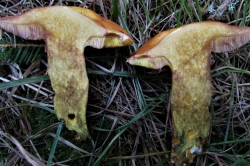
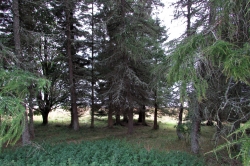
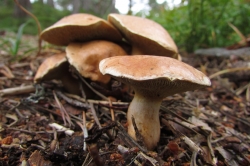






7 comments for Larch Bolete
Lots on tha Ashdown Forest. Pine trees but not larch trees. Not certain they are actually the bovinus
Found a bunch on them in Torbreck woodlands near Inverness.
Justa
found near campsie hills in the car park
Well my experience of cooking this mushroom fresh today was quite the reverse of the advice on this page and elsewhere.
I found some larch boletes growing near brown birch boletes and bay boletes in a small section of woodland with birch and larch. The weather here has been rather dry, the ‘better’ boletes weren’t very numerous and nothing much else was around – moreover these particular larch boletes looked young and firm and quite appetizing, unlike some of the ones I’d seen in previous years – so I thought why not give them a go this time along with the others? Anyway peeling them was a nuisance but they turned out perfectly and were delicious. Not mushy at all.
Out of the three types of mushroom in the pan, somewhat remarkably the larch boletes were the firmest and strongest flavoured of all, with a very long lingering aftertaste, though it has to be said that I prefered the rich ‘dry’ umami flavour of the brown birch boletes, despite their soggier texture. The bay boletes were a good all-rounder.
All of these mushrooms were good young fresh examples and I am sure of their identifications!
Contrast this with a previous year when I tried to dry a larch bolete – or it may have been a slippery jack – I can’t remember. The weather had been wet and the mushroom was mushy, very slimy and a little bit maggoty and did not look very appetizing. There was almost nothing left after I peeled it and what remained shrank to less than that when dried and went a funny colour. I didn’t like the look of it so in the end I threw it out!
I think the lesson is – as with all wild mushrooms – only eat them when they’re young and fresh!
Found some of these by the side of a woodland path in Ceredigion, Wales, September 2022. Did not try to cook them as hadn’t yet identified, and there were some perfect porcini nearby.
Thankyou for this wonderful service! Super helpful. 🙂
Found three small ones today in Thetford forest, quite dry but first edible mushroom this year so cant complain!